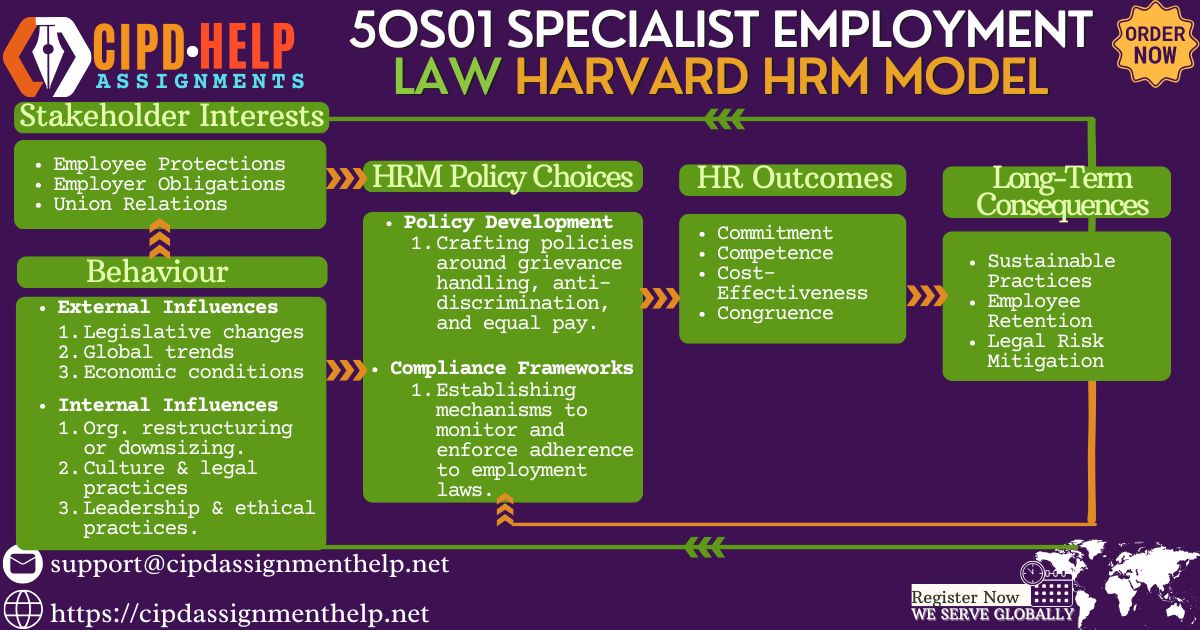5OS01 Specialist Employment Law Assignment Help Outline
Assignment Task 1: Understand the purpose of employment regulation and the way it is enforced in
practice.
Evaluate the aims and objectives of employment regulation.
- Give a brief description of employment regulation
- Aims and objectives of employment regulation
- Protect employees – for example, by preventing bias/discrimination in the workplace
- Provide legal protection for both employees and employers
- Promote social justice in the work place – for example; it promotes equality and opportunity for all
- Evaluation
- Do these aims and objectives effectively cover regulation of the relationship between the employer and employee?
- Do they effectively define the expectations of the employer to the employee and the vice versa?
- What are the implications for people practice professionals in organisations?
- Counterargument – What if there is no employment regulation, What are the negative impacts?
Examine the role played by the tribunal and courts system in enforcing employment law.
- Give a brief description of tribunal and court system for employment law in the UK
- What does the enforcement of employment law entail?
- The role of tribunal and court system in enforcing employment law in the UK
- Hear claims
- Make decisions
- Allow appeals
- The employment tribunal
- Hear and decide case between workers and employers – for instance equal pay and unfair dismissal
- Hear and decides appealed employment cases
- The court system – include Criminal courts, civil courts, High Court, Court of Appeal
- Hear and decide employment cases from employees against their employers
- Hear and decides appealed cases
- The employment tribunal
Explain how cases are settled before and during formal legal procedures.
- Give a brief description of formal legal procedures
- The process of settling cases before and during formal legal procedures
- Before
- Settlement agreements
- Conciliation – for example; mediation, the involvement of Advisory, Conciliation and Arbitration Service (ACAS),
- During
- Court or employment tribunal
- Before
- Give a detailed description of the process involved in each step of formal legal procedure
- What are the benefits of following the legal procedure in settling employment case?
- What are the implications for people practice professionals?
Assignment Activity 2: Understand how to manage recruitment and selection activities lawfully.
Evaluate the principles of discrimination law in recruitment, selection and employment.
- Give a brief description of the discrimination law in recruitment, selection and employment
- Principles of discrimination law in recruitment, selection and employment
- Follow the Employment Standards Act
- Pay Equity Act
- Human Rights Code
- Health and Safety Act
- Labour Relations Act
- Evaluation
- What does the law say in regard to these principles?
- How effective are these principles in preventing discrimination during recruitment, selection and employment?
- What are the implications for people practice professionals in organisations?
Discuss the legal requirements of equal pay.
- Give a brief description of equal pay
- The legal requirements of equal pay
- Men and women must get equal pay for doing ‘equal work
- Equal pay law is applicable to pay and contractual terms and conditions. For example; sick pay, basic salary, benefits, redundancy pay, working hours, overtime pay
- Equal pay is applicable to agency workers, workers, employees, apprentices, contracts (full-time, part-time or temporary contracts), self-employed people hired to personally do the work
- Differences in equal pay may apply based on;
- Higher level of skills
- Location
- Different shifts – with good reasons to pay one shift more than the other
- What are the implications for people practice professionals in organisations?
Assignment Brief 3: Understand how to manage change and reorganisation lawfully.
Discuss the legal implications of managing change.
- What does it involve as change in employment law? For instance; change of employment contracts
- What does it involve when changing employment contracts in organisations?
- The legal implications of managing change
- Review the contract(s)
- Understand the legal framework
- Ensure compliance
- Consider to prevent discrimination in the workplace
Explain the legal requirements relating to transfers of undertakings.
- Give a brief description of transfers of undertakings?
- The legal requirements relating to transfers of undertakings – for both (incoming and outgoing) employers
- Provide schemes of substantial equivalence
- Protect employee’s employment rights
- Inform and consult employees
- Provide employee liability information
- What are the obligations of the employers based on the above legal requirements?
- What are the implications for people practice professionals in organisations?
Learning Outcome 4: Understand how to manage issues relating to pay and working time lawfully.
Explain the major statutory rights workers have in relation to pay.
- Give a brief description of major workers statutory rights
- The major statutory rights workers have in relation to pay
- Full pay – National minimum wage
- No deductions without cause – protection from unlawful deductions
- Non-discrimination – equal pay
- Fair remuneration
- Rights to go on strike and join trade union
- How are workers protected under the law based on the above statutory rights?
- What are the implications for people practice professionals in organisations?
Explain the major statutory rights in leave and working time.
- Major statutory rights workers have on leave
- Fully paid statutory leave
- Fully paid sick leave
- Fully paid maternity, paternity, shared parental or adoption leave
- Major statutory rights workers have on working time
- Working part-time
- Working irregular hours or part of the year
- Bank or public holidays
- Statutory minimum length of rest breaks
- How are workers protected based on the above statutory rights?
- What are the implications for people practice professionals?
Explain the main principles of maternity, paternity and adoption rights in the context of employment rights.
- Give a brief description of employment rights
- Give a brief description of maternity, paternity and adoption rights for workers
- The main principles of maternity, paternity and adoption rights in the context of employment rights
- Maternity rights
- Right to maternity leave
- Right to maternity pay – for example, stator maternity pay or enhanced maternity pay depending on the scope of eligibility,
- Redundancy protection rights
- Health and safety rules and penalties in the workplace
- Paternity rights
- Right to paternity leave
- Right to paternity pay – for example statutory paternity pay, enhanced paternity pay depending on the scope of eligibility
- Redundancy protection rights
- Adoption rights
- Right to statutory adoption leave
- Right to statutory adoption pay
- Right to shared parental leave and leave
- Redundancy protection rights
- For all types of rights, the employee is entitled to;
- Pay rises,
- Accrue usual holidays
- Right to return to work
- Maternity rights
Explain other employment rights relating to flexible working.
- Give a brief description of flexible working
- Other employment rights relating to flexible working
- Right to request flexible working
- Right to request for two statutory flexible working per year
- Right to get the request decision within two months from the employer
- Right to be consulted by the employer before rejecting a request





